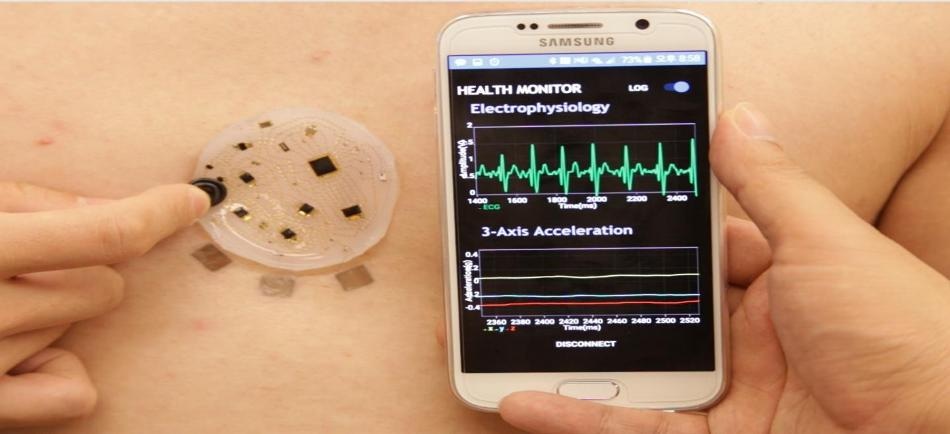Aug 22 2017
A new, electronic skin microsystem monitors respiration, muscle movement, heart rate and other health data, and wirelessly communicates it to a smartphone.
The electronic skin offers a number of improvements over currently available trackers, including smaller size, better flexibility and the ability to stick the self-adhesive patch - which is a very soft silicone approximately 4 cm (1.5”) in diameter – virtually anywhere on the body.
 A research team led by Professor Kyung-In Jang of Robotics Engineering collects, analyzes, and diagnoses bio-signals wirelessly transmitted to mobile application from the soft electronic skin. (Credit – DGIST)
A research team led by Professor Kyung-In Jang of Robotics Engineering collects, analyzes, and diagnoses bio-signals wirelessly transmitted to mobile application from the soft electronic skin. (Credit – DGIST)
The microsystem was created by an international team led by Kyung-In Jang, a Professor of Robotics Engineering at South Korea's Daegu Gyeongbuk Institute of Science and Technology, and John A. Rogers, the Director of Northwestern University's Center for Bio-Integrated Electronics. The team illustrated the new device in the Nature Communications journal.
The electronic skin has approximately 50 components connected by a network of 250 miniature wire coils embedded in protective silicone. Unlike other hard monitors, the soft material allows it to conform to body. It wirelessly communicates data on movement and respiration, as well as electrical activity in the heart, eyes, muscles and brain to a smartphone application.
Unlike flat sensors, the miniature wires coils in this device are three-dimensional (3D), which maximizes flexibility. The coils can contract and stretch in the same manner as a spring without breaking. The coils and sensor parts are also configured in an uncommon spider web pattern that guarantees 'uniform and extreme levels of stretchability and bendability in any direction.' It also enables tighter packing of parts, reducing size. The Researchers compare the design to a winding, curling vine, connecting circuits, sensors and radios like separate leaves on the vine.
The important aspect in making this novel microsystem is stretching the elastic silicone base while the miniature wire arcs, composed of chromium, gold and phosphate, are placed flat onto it. The arcs are securely connected to the base only at one end of each arc. When the base is allowed to contract, the arcs pop up, creating 3D coils.
The whole system is powered wirelessly instead of being charged by a battery. The Researchers also considered important mechanical and electrical issues to improve the system's physical layout, such as wire length or sensor placement, to reduce noise and signal interference.
The electronic skin could be used in a range of applications, including nonstop health monitoring and disease treatment.
Combining big data and artificial intelligence technologies, the wireless biosensors can be developed into an entire medical system which allows portable access to collection, storage, and analysis of health signals and information. We will continue further studies to develop electronic skins which can support interactive telemedicine and treatment systems for patients in blind areas for medical services such as rural houses in mountain village.
Kyung-In Jang, Professor of Robotics Engineering, South Korea's Daegu Gyeongbuk Institute of Science and Technology
The microsystem could also be used in other areas of emerging interest, such as autonomous navigation or soft robotics, which the team is at present exploring.